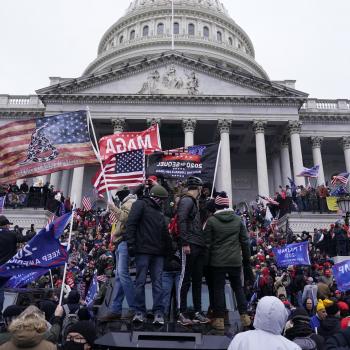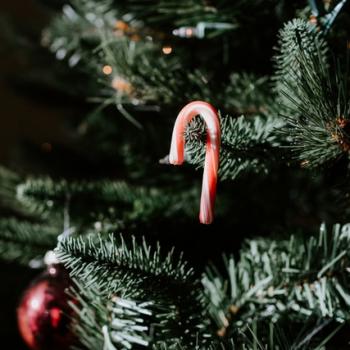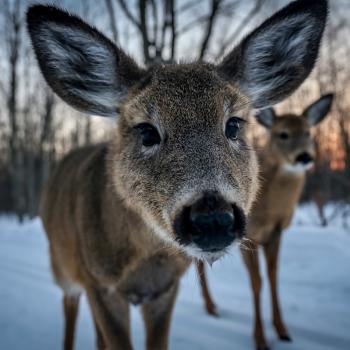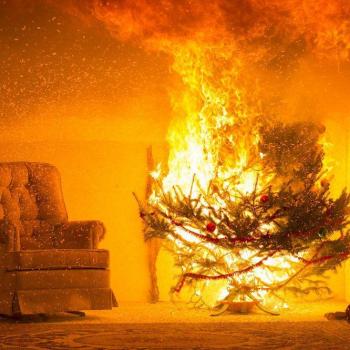Advent Week 2:Bible Study and Discussion Questions
Why do we never see John the Baptist on a Hallmark card? Or a giant, blow-up snow globe to put in your yard? Come to think of it, we don’t even include him in our sanctuary tableau. Our songs, our greetings, our pageantry, all seems to skip straight from Isaiah to the annunciation. What it comes down to, I think, is that the wayward 2nd cousin is just not sexy. Not like the angels—I mean, they’ve had a whole holiday lingerie show modeled after them! (More on the $2-million-dollar fantasy bra later). He’s not romantic, like the simple hillside shepherds. He’s not waif-like and virginal, like the uber-westernized Holy Mother of our nativity plays. He’s not mysterious and stately like the wise men. He’s not adorable like the baby Jesus (he’s still our favorite Jesus). No, there’s not much place for the desert prophet in our red, green and glittering displays.
I used to work at a large, old, downtown church with a beautiful sanctuary. Needless to say, this church did plenty of non-member weddings. One day, the wedding coordinator was out, and a bride who was to be married the weekend of Christmas came in to show her mother the (old, beautiful) sanctuary. Can you imagine the mother’s surprise when she entered and saw the Advent decorations, at this point already lovingly hung by church women…not the red, green and gold to be sported by the wedding party, but purple! Silver! She was not pleased. “Will we be able to take all this down for the ceremony?” she wanted to know. “It doesn’t match the dresses!”
Um… Add to the list of “things they don’t teach you in seminary…” To my credit, I said no politely and went on to assure her that, in that very large space, once you filled it with people and the beautiful bride and the young, attractive attendants, the purple stuff would just blend in. To the bride’s credit, she said simply “mom, it will be fine.” Crisis averted.
I feel this is what happens with J the B (as I’ve come to lovingly call him, since becoming a desert-dweller myself). We kind of like the idea of him, in theory, but well…put up the angels, the shepherds, the made-for-tv teen-age mom, and the gift-bearing royalty, and you know, he just doesn’t match. The Baptizer embodies a wilderness that we’ve long abandoned, except for vacations or the occasional retreat. And the desert, really, is the last place we want to visit in this season. Bring on the snow! The evergreen! The crackling fire! Nobody wants to hike a scraggly, rocky foothill and cut down a Christmas cactus.
Some speculate that J the B may have lacked a certain soundness of mind. Now that I live in the desert myself, I am certain that he did. No one would choose this life without amenities. Surely none would journey to such a barren place without climate control, sunscreen, iced coffee and water slides. We’ll come back to our desert-comforts later. But first: with or without all his marbles, what does John have to teach us about the coming Jesus boy? Let’s start with context.
The opening sentences of Mark’s gospel proclaim that good news is coming. What could be more Christmass-y than that? John’s opening monologue harkens back to the prophet Isaiah—also a voice in the wilderness. When J the B echoes that elder prophet’s call to “prepare the way of the Lord,” he invokes God’s intention for humankind in both a past/historical sense, and a present-and-coming sense. That sense of continuity is critical for Mark’s readers. It sets up a God that people know and remember, who is now doing new things in their midst, in their time and place. Unbelievable! Naturally, the simple passing reference to Isaiah puts the gathered crowd in mindfulness of wandering. Memory is a powerful tool, and waiting by the riverside, in the presence of the baptizer, they cannot help but remember…the wilderness place of their ancestors. The years of uncertainty, of waiting, and of the signs of God’s faithfulness that appeared there, again and again. In this new prophet’s call to prepare, they hear an echo of liberation and of hope.
There is something about a barren landscape that reads like a blank canvas for transformation. We so often equate wilderness with despair, pain, loss, and suffering… that place from which we have no place to go but up! And while some of our wilderness places can certainly feel that way, wilderness has another value as well…It also marks the place where we can begin a letting go of our comforts and resources, and see what is left of us when all titles, pretense and STUFF is gone. That’s the place where we truly meet the holy, the place where God can do a new thing in us, and the place in which we can expect to greet the Christ child. In short, it is place of true worship. And while it does not have to be quite a literal desert, something deep within us craves a big of wilderness from time to time. And while the ‘holiday season” is probably the least convenient time to go seek it out, this might also be the frame in which we need it most desperately.
* * *
My husband and I visit National parks any chance we get, and often go out of our way to experience one. It is always worth it. Always. When the Ken Burn’s documentary, “National Parks: America’s Best Idea” came out, it was fun to watch and say, “hey, we’ve been there!” over and over again. Just to lend some insight as to the spiritual value of our parks system—and this film—the first episode is entitled “The Scripture of Nature.” The film is full of historical reference, fact, and educational content. But beyond that, this creative venture explores the deeper narrative value of our most beautiful natural resources. These places renew and restore us, call us to venture outside of our yards, our routines, and even ourselves.
What happens when we do that? We are ready to meet the holy. We are ready to encounter God, the Creator, in a whole new way. We acknowledge the potential for the miraculous; having seen it living all around us, we come to believe that it can live within us. One person in the film reflected, “in these spectacular spaces, we do not need to be reminded that there’s a higher power. We don’t have to be urged to worship. The presence of God is all around us, and we cannot help but be fully aware of it.” There is much truth in her statement, not only about the power of nature, but about the essence of worship. What could possibly lend an indoor worship service that kind of power? What if just walking in the door of the sanctuary was to be fully and inescapably in the presence of God?
While we can’t quite fit the Grand Canyon in our buildings, we can certainly think about how effectively our worship enables us to sit in God’s presence, and whether it invites us to the kind of awe-struck breathlessness that we experience in the great outdoors. What inspires and uplifts you in worship? What makes you doze off, or wish you’d stayed home to watch football? When are you most aware of the living, moving Spirit in community? “In America, magnificence is a common treasure. That’s the essence of our democracy.” Its also the nature of our faith, in the sacred trust of the gospel that is ours to share and keep alive, and in the shared experience of worship. If you need to be reminded of how beautiful this life of faith really is, just get outside and look.
We have 3 national parks in Arizona, and a whole mess of state parks and national monuments. That leads me to believe that many of our neighbors share our appreciation of natural wonders, and of taking time out to just take them in. The landscape around us is just full of God’s glory, just full of the kind of heart-stopping, transforming beauty that people come seeking from all the world over. Places of stark natural beauty have the power to make us feel at once miraculous and miniscule. The one who created ALL THIS also made me, we might think. It points out the truth of our mortality, and the truth of our sacred core all in the same moment. In the presence of such real and holy truth, we are certain, if only for a moment…we were made for love, we were made for peace, we are surrounded on every side by the God of our being. And yeah, all of a sudden, that mile long December to-do list does not seem so imposing. The burden of the world is at once laid upon us and removed. This is the kind of preparation, this sacred awareness, the prophets spoke down through the years. It is at once terrifying and comforting.
John Muir, the godfather of our National Parks system, was kind of a contemporary J the B. He wandered in the wilderness a lot; he wore a lot of camel hair (or equivalent thereof); and people thought he was crazy. But whereas John wanted folks to make a highway in the wilderness…well, J the Muir wanted to leave a bit of wilderness along the highway. And there is the difference between ancient prophets and new.
Thanks to John Muir, we all own a little bit of wilderness. We all have access to a place of stark natural beauty, whether it is evergreen mountain, high plain or low desert, shifting sand or ebbing tide, swamp or grassland or deepest, darkest cave… Wherever you live in this nation, you are never more than a couple hours’ drive from someplace holy. What a gift it would be to yourself if, sometime in this season, you skipped a shopping trip or a cookie exchange and drove, hiked or biked yourself to a place of sacred longing and emptiness.
–“ A few minutes ago every tree was excited, bowing to the roaring storm, waving, swirling, tossing their branches in glorious enthusiasm like worship. But though to the outer ear these trees are now silent, their songs never cease.” John Muir
* * *
Un-sexy though he might be; questionable as his diet and living arrangements may seem; John the Baptist’s story might be the best version of good news for our place and time. His dramatic critique of the world could only be answered in wilderness, where no influence of human flesh could touch him. Perhaps it’s nothing new for people of faith to call for a simpler life, or to seek a quiet, waiting spirit… But in this time of economic uncertainty, threats of terror, pandemic and planetary demise, there might be a newness, this time, in those of us who hear. This season, we might just be ready to seek the holy in a wilderness, away from some of our seasonal comforts which—let’s just face it—can get expensive and burdensome.
Case in point—the Starbuck’s fancy holiday mocha-ccino-latte thing. Let’s all admit that there are dark, cold, chilly days wherein we would spend any amount of money for the comfort of that cheerful red snowflake cup. In the valley of the sun, December is not the season of frozen earth, dreary afternoons and barrenness. This is what we live for in the blazing summers! Oh, the beauty of this valley in December! Cold nights (but not freezing!) chilly mornings, mild afternoons, 50′s and 60′s, sunny with a crayon blue sky. Even so, there’s something comforting about the combination of warmth, sugar and caffeine. Add in the seasonal container, and we are hooked.
What’s crazy is that you can go into Starbucks in December when it is legitimately chilly out, and they have running, I’m not even joking, the AIR CONDITIONER!! Now, to me, the only way to justify the $500 utility bill in July is to know that I can live several months of the year with neither heating nor cooling device (or with very little help from either). For about four months of the year, life is pretty much perfect around here with no climate control, with doors and windows open for sunshine and fresh air. Why then, on a day when one could live without it; could maybe even turn up the heat would someone run the air to make it cooler? We could lament the tragedy of American excess, but there’s more at work here.
When you spend an extended period of time having to create your own comfort, you forget how to let nature provide it for you. You forget about contentment, joy, and peace. Even when happier times descend, you might cling to the misery like a favorite sweater, because you’ve become so accustomed to it. After long, hard months spent in the heat of the desert, you simply forget that the earth can cool you of its own accord. You forget that comfort, even perfection, can come to you naturally, without your having to strive for it, or force it from limited resources. You forget how to turn off the air.
Ultimately, we come to rely on the comforts that we must provide for ourselves. We forget that it’s God’s job, and we forsake natural amenities in favor of our own.
How many of us, in this season, are living long months in the wilderness of debt; unemployment; lonliness; addiction; loss; disappointment; and now cling to the barren ground as long as it will embrace us back? That’s where faith takes us this advent season; not just on our own journey through the wilderness and to the stable where new life is found. But out into our neighborhoods, seeking those who hang onto sorrow, and reminding them of another kind of embrace. We are called to retrace our steps through the desert, and gather the straglers into a life of community, purpose and–dare we hope it?–even joy. There may be some who never knew that life; others who knew it once but forgot. Among them, many will be reluctant to turn off the toxic air they’ve been circulating these long, lonely months.
For all that we have filled it with false comforts, this is a rare season when the desert can provide what we need. In this precious space of a few weeks, we can dial back the auto-mated, pre-programmed and store-bought sources of air and light. We can remember what it looks like in its natural form and, the stable ever closer, rejoice with the windows open.
You know, come to think of it…The Starbucks folks are totally messing with us. They KNOW it’s too cold to be running the a/c. But the colder we are, the more cash we’ll shell out for good cheer in a red cup. They’re on to us. The good news is, so is the prophet John. He reminds us of a deeper longing that cannot be answered in a caffeinated beverage. This appearance of John the Baptist stands as merely a prologue to the rest of Mark’s gospel—the good news of God’s love made flesh and living among us. And yet, that prologue embodies all the hope and expectancy of the season. By pointing to the past and alluding to the future, the Baptizer alludes to the broad and sweeping work of God throughout all nature and history. The wilderness setting hints at the difficulty ahead, but also promises a wholeness and certain peace for the journey.
Are we ready to put him in our sanctuary tableau yet? Dress one of the youth in camel hair and work them into the pageantry? It’s the new thing, really…the substance that is universal in it’s necessity, the piece that everybody must have in their closets this season. Abandon just some of the glitter and glam and, if only for a moment, be in a place of quiet stillness and natural beauty. How blessed we are to have some wilderness in our back yard, and good reason to go wandering there. The word of God becomes flesh among us. It settles upon us with a certain peace, then moves us out with restless longing. It’s the cycle of our days that keeps the good news moving through the world, from Isaiah to the Baptizer, even to John Muir, and down to you and me. Sometimes we must carve a highway in the desert. And sometimes, we must preserve some sacred desert along the highway. Do what you have to do, go where you must; let go what encumbers you, escape all that burdens; if we are to welcome this coming one, we must be ready to hear the good news. All earth is waiting…
* * *
Questions for discussion:
–Why does John the Baptist quote the prophet Isaiah as he preaches?
–Mark’s gospel has no story of Jesus’ birth or childhood; how does the Prologue (Mark 1:1-8) still work to set up the story of Jesus life and ministry, and “prepare” the reader for the journey ahead?
–What is a wilderness place that is special to you? How do you experience the holy in that space?
–How can we make time and space for wilderness in the midst of this full and busy season? Why is it important that we do so?
–We often think of the desert or the wilderness as a place of barrenness. When is the wilderness a place of good news?











